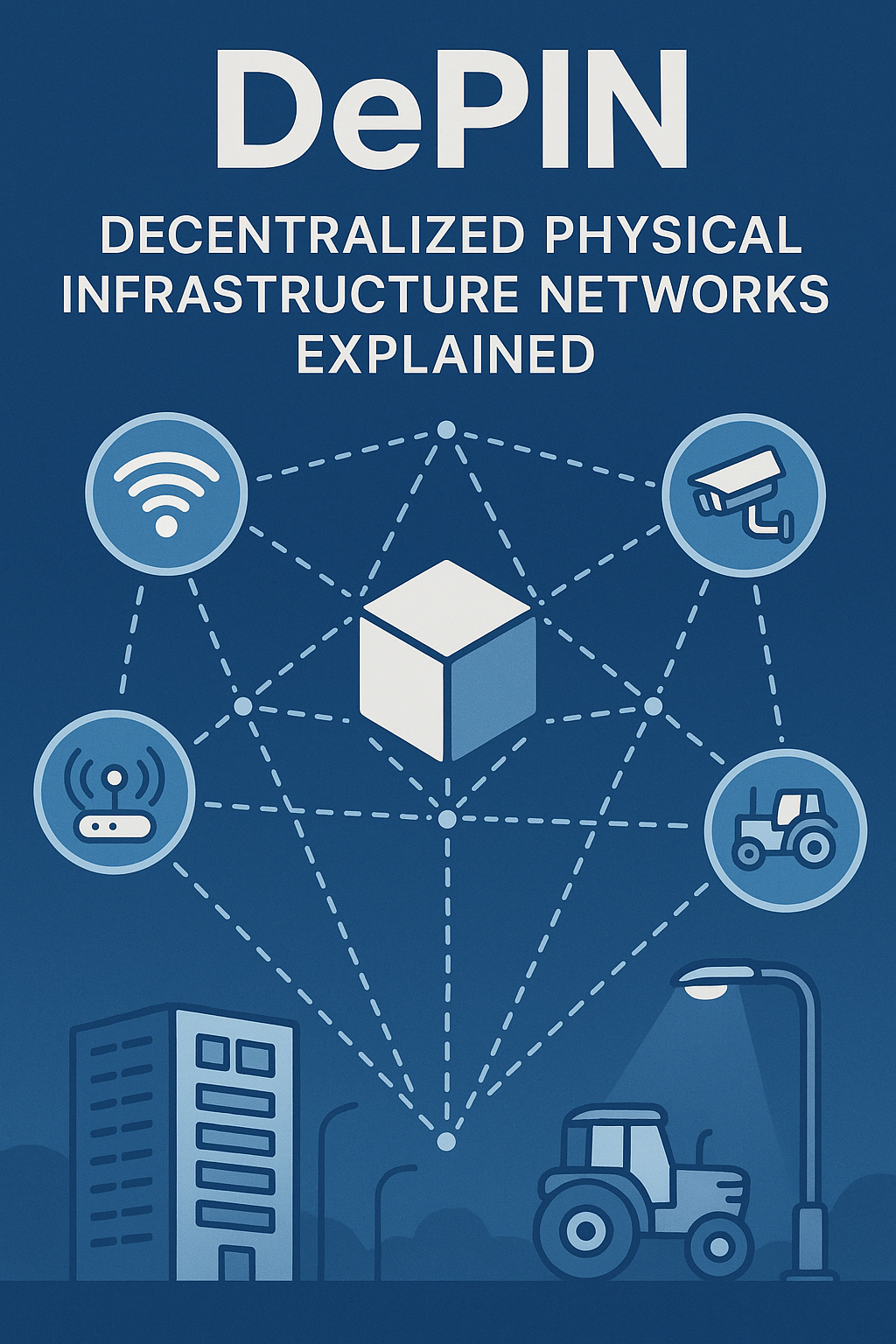DePIN: Decentralized Physical Infrastructure Networks Explained

What is DePIN?
DePIN stands for Decentralized Physical Infrastructure Networks, a rising trend in Web3 that uses blockchain incentives to crowdsource and maintain real-world infrastructure like WiFi, GPS, storage, compute, or even energy.
Think of DePIN as the decentralized version of companies like Uber, Airbnb, or Amazon Web Services, but without a centralized company controlling the network. Instead, individuals provide the resources and are rewarded with crypto tokens for their contributions.
How Does DePIN Work?
At its core, a DePIN project connects physical resources to the blockchain using the following layers:
| Layer | Role |
|---|---|
| Hardware | Devices provide services (e.g., sensors, hotspots, satellites, servers) |
| Middleware | Bridges real-world data to the blockchain (e.g., oracles, IoT integrations) |
| Token Incentives | Users are rewarded with tokens for running nodes or contributing data |
| Blockchain Layer | Stores reputation, payments, data logs, and ensures transparency |
This model aligns perfectly with modular and scalable blockchain ecosystems like Arbitrum and liquidity infrastructure like Mitosis ✅, which enable smooth cross-chain coordination and rewards distribution.
Why DePIN Matters
DePIN challenges the centralized status quo by turning real-world services into permissionless, community-owned networks. Here’s why it’s a big deal:
- Lower Cost of Infrastructure: Anyone can join and earn, lowering deployment costs.
- Decentralized Ownership: Infrastructure isn’t owned by a single company.
- Transparency & Verifiability: Contributions and rewards are logged on-chain.
- Global Reach: Anyone with hardware can contribute, from urban centers to rural areas.
These traits make DePIN ideal for developing economies, underserved regions, and systems where centralized providers dominate — echoing the cross-chain, permissionless nature of Mitosis’s liquidity routing ✅.
Examples of DePIN Projects
| Project | Function | Description |
|---|---|---|
| Helium | Wireless Coverage | Users deploy hotspots and earn HNT for providing LoRaWAN & 5G |
| Render Network | GPU Compute | Users rent out unused GPU power for rendering tasks |
| Filecoin | Decentralized Storage | Anyone can rent out unused hard drive space |
| DIMO | Vehicle Data | Drivers share anonymized vehicle data for rewards |
| Hivemapper | Maps | Dashcam-equipped drivers earn tokens for mapping roads |
These networks need scalable and interoperable backbones, which is where Mitosis’s modular infrastructure ✅ plays a critical role in reducing friction across multiple chains and layers.
What Powers a Successful DePIN?
A strong DePIN network typically combines:
- Real-World Demand: Services like storage, compute, or mobility that are expensive or monopolized.
- Incentive Design: Sustainable tokenomics that reward useful contributions, not just participation.
- Reliable Middleware: Bridges that ensure real-world data is verifiable on-chain.
- Cross-Chain Interoperability: Many DePINs interact with users and apps on multiple chains. Infrastructure like Mitosis Cross-Layer Messaging ✅ allows seamless coordination between L1s, L2s, and appchains.
Why Mitosis Matters to DePIN Builders
Mitosis offers a trustless, fast liquidity network that enables DePIN protocols to route value across chains. Whether it’s handling token rewards, staking, or accessing DeFi primitives, Mitosis Yield Vaults ✅ empower DePIN protocols to offer real yield to their contributors.
This unlocks powerful synergies:
- Liquidity across ecosystems for DePIN token utility
- Programmable reward flows using smart contract hooks
- Gasless bridging for onboarding non-crypto users
In a world where DePIN must compete with Web2 efficiency, Mitosis offers the composability and liquidity layer they need to scale.
Challenges to Watch
While promising, DePIN isn’t without hurdles:
- Data Validation: Ensuring contributions are real and not faked (Sybil attacks)
- Sustainable Rewards: Avoiding Ponzi-like models where rewards dry up quickly
- Hardware Access: Requires people to buy and manage physical devices
- Network Effects: Like any network, DePINs need users and providers to hit critical mass
Protocols that integrate Mitosis for multi-chain liquidity help DePIN ecosystems grow faster and more sustainably.
Final Thoughts
DePIN represents a revolution in how we build and operate infrastructure, shifting ownership from tech giants to communities.
To succeed, these networks need tools that are modular, interoperable, and trustless, exactly the properties offered by Mitosis. As both DePIN and modular blockchain infrastructure evolve, protocols like Mitosis will be central to ensuring these networks scale globally, efficiently, and fairly.

Comments ()